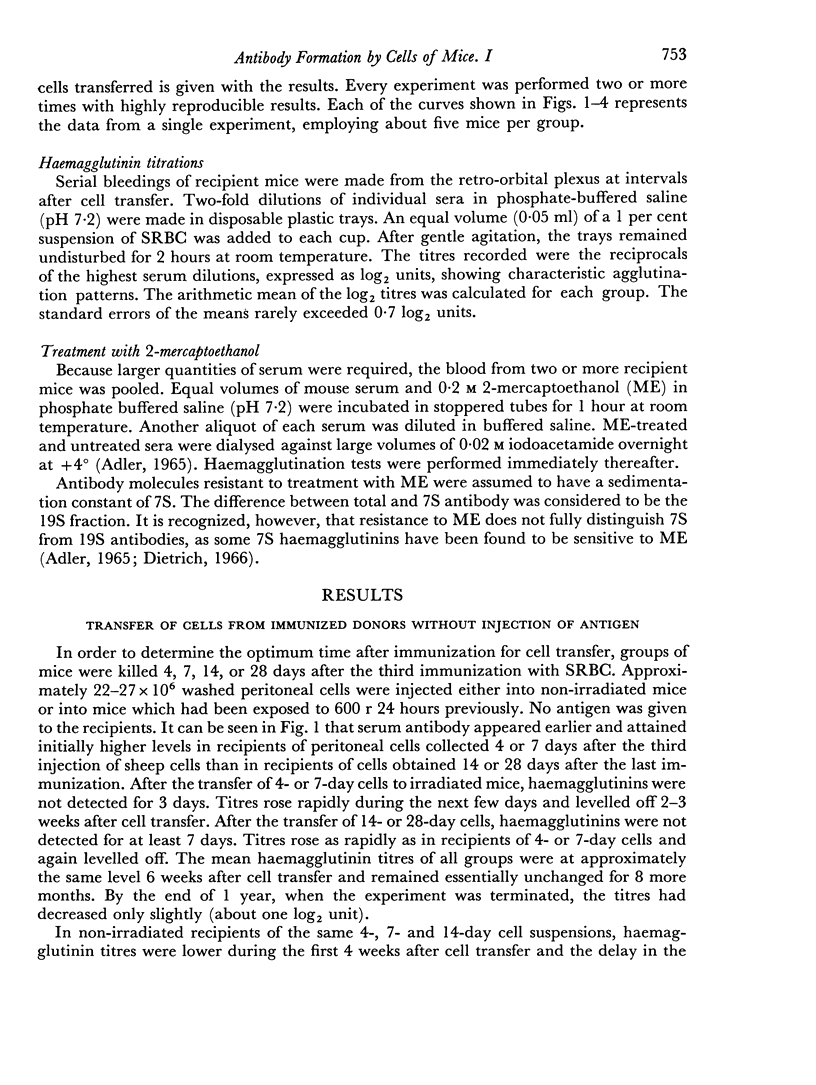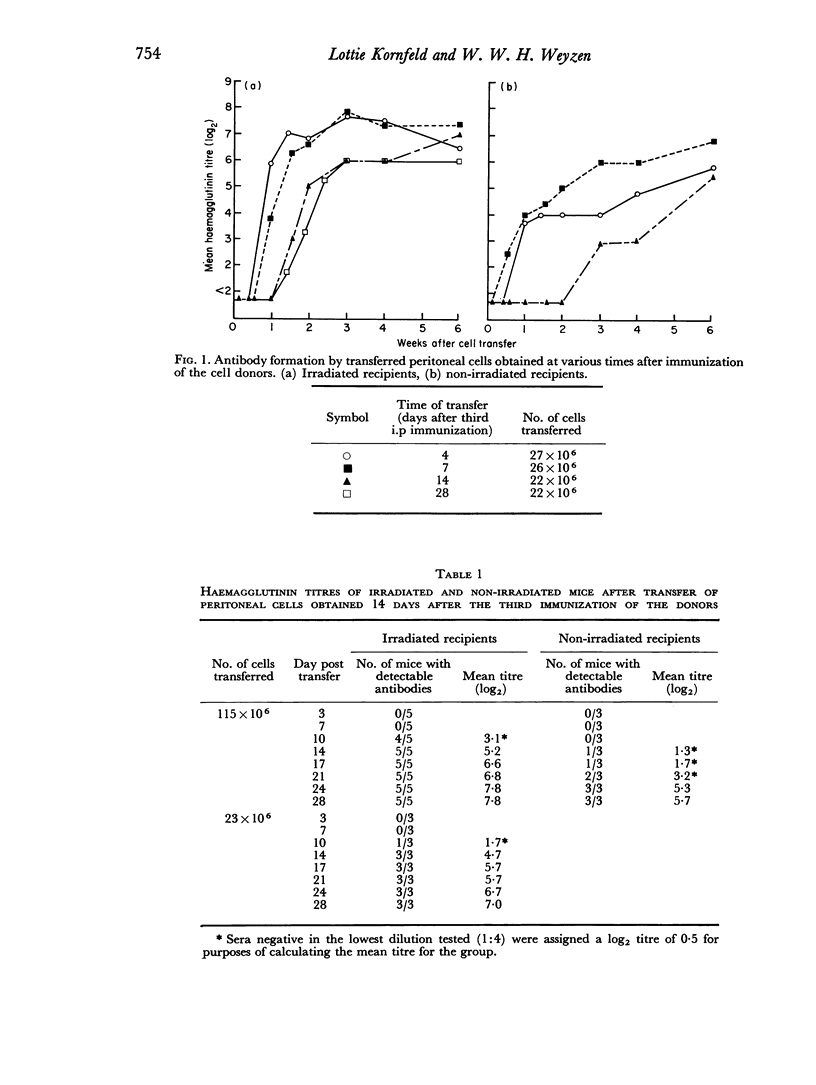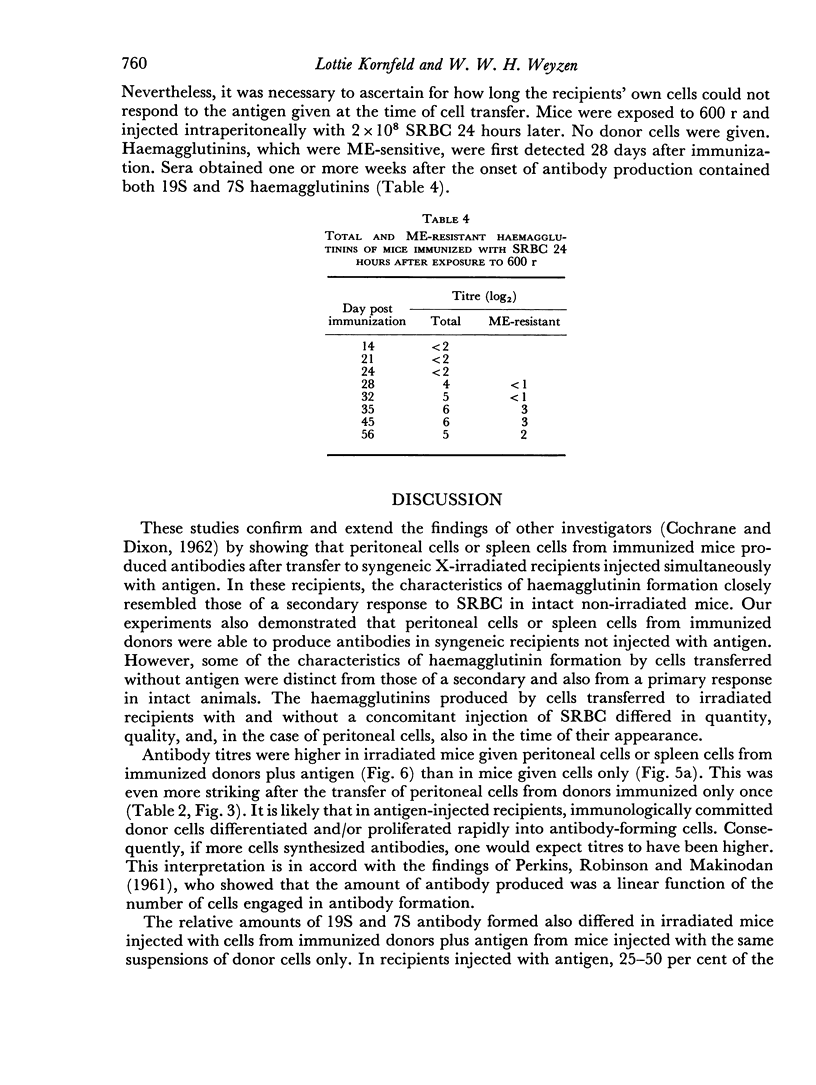Abstract
Peritoneal cells and spleen cells from LAF1 mice given three intraperitoneal immunizations of sheep red blood cells synthesized haemagglutinins after transfer to X-irradiated syngeneic recipients, either with or without a concomitant injection of antigen. Antibody formation by cells transferred with antigen resembled a secondary antibody response in intact animals. Haemagglutinins appeared rapidly and in high titre. Approximately 50 per cent of the antibodies were resistant to treatment with 2-mercaptoethanol.
Antibody formation by cells transferred without further exposure to antigen differed in several respects. Haemagglutinin titres were lower. Throughout the period of observation, only 6–25 per cent of the antibodies formed were mercaptoethanol-resistant. In recipients injected with spleen cells, antibodies appeared rapidly, suggesting that mature antibody-forming cells had been transferred. However, in recipients injected with peritoneal cells from the same donors, antibodies were detected only after a delay of several days, which suggested that mature antibody-forming cells had not been transferred. Haemagglutinins were synthesized equally well after transfer of all types of peritoneal cells or of a fraction consisting almost entirely of lymphoid cells. Recipients of peritoneal cells from donors which had been given either one intraperitoneal immunization or three intravenous immunizations had no or only low haemagglutinin titres, in contrast to recipients of cells from donors given three intraperitoneal immunizations.
These observations suggest that antibody formation in recipients of peritoneal cells only, i.e. without further stimulation by antigen, can be attributed to cells which are present in the peritoneal cavity of donors immunized repeatedly by the intraperitoneal route, but which are not part of the active antibody-synthesizing apparatus of the donors at the time of cell transfer. The development of these cells into antibody-forming cells can be detected only in an environment devoid of antigen and of mature antibody-forming cells. It is postulated that these cells are distinct from cells which respond on re-exposure to antigen.
Full text
PDF













Selected References
These references are in PubMed. This may not be the complete list of references from this article.
- ADLER F. L. STUDIES ON MOUSE ANTIBODIES. I. THE RESPONSE TO SHEEP RED CELLS. J Immunol. 1965 Jul;95:26–38. [PubMed] [Google Scholar]
- Blinkoff R. C. Gamma-M and gamma-G antibodies in mice: dissociation of the normal immunoglobulin sequence. J Immunol. 1966 Nov;97(5):736–746. [PubMed] [Google Scholar]
- Dietrich F. M. The immune response to heterologous red cells in mice. Immunology. 1966 Apr;10(4):365–376. [PMC free article] [PubMed] [Google Scholar]
- JERNE N. K., NORDIN A. A. Plaque formation in agar by single antibody-producing cells. Science. 1963 Apr 26;140(3565):405–405. [PubMed] [Google Scholar]
- Kornfeld L., Greenman V. Effects of total-body x-irradiation on peritoneal cells of mice. Radiat Res. 1966 Nov;29(3):433–444. [PubMed] [Google Scholar]
- MAKINODAN T., GENGOZIAN N. Primary antibody response to a distantly related heterologous antigen during maximum depression period after varying doses of x radiation. J Immunol. 1958 Aug;81(2):150–154. [PubMed] [Google Scholar]
- Makinodan T., Albright J. F. Proliferative and differentiative manifestations of cellular immune potential. Prog Allergy. 1967;10:1–36. [PubMed] [Google Scholar]
- NOSSAL G. J., SZENBERG A., ADA G. L., AUSTIN C. M. SINGLE CELL STUDIES ON 19S ANTIBODY PRODUCTION. J Exp Med. 1964 Mar 1;119:485–502. doi: 10.1084/jem.119.3.485. [DOI] [PMC free article] [PubMed] [Google Scholar]
- PERKINS E. H., ROBINSON M. A., MAKINODAN T. Agglutinin response, a function of cell number. J Immunol. 1961 May;86:533–537. [PubMed] [Google Scholar]
- Uhr J. W., Finkelstein M. S. The kinetics of antibody formation. Prog Allergy. 1967;10:37–83. [PubMed] [Google Scholar]
- WEILER E. DELAYED ANTIBODY SYNTHESIS IN MICE AFTER TRANSFER OF IMMUNE PERITONEAL FLUID CELLS. Immunology. 1964 May;7:197–212. [PMC free article] [PubMed] [Google Scholar]
- Weiler I. J., Weiler E. Association of immunologic determination with the lymphocyte fraction of the peritoneal fluid cell population. J Immunol. 1965 Aug;95(2):288–294. [PubMed] [Google Scholar]


